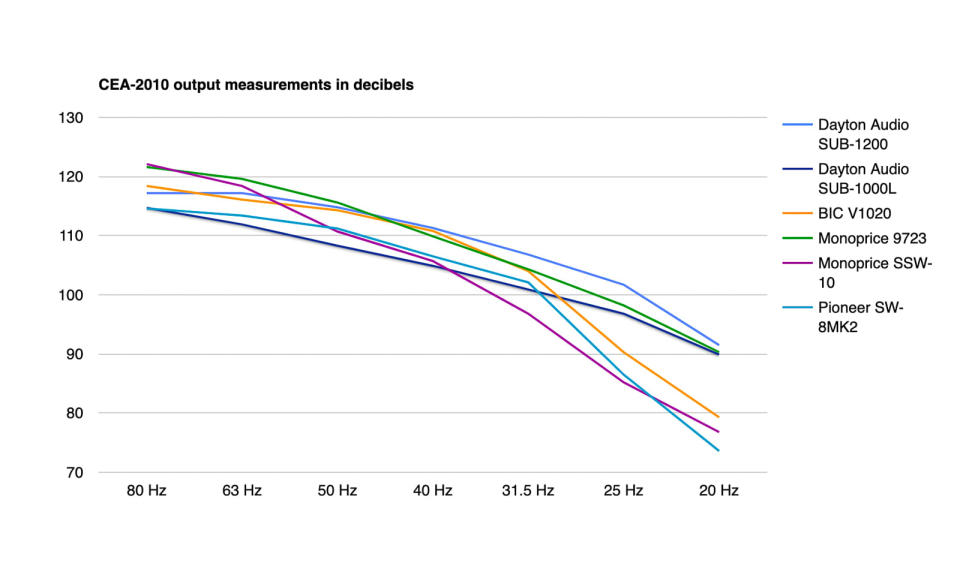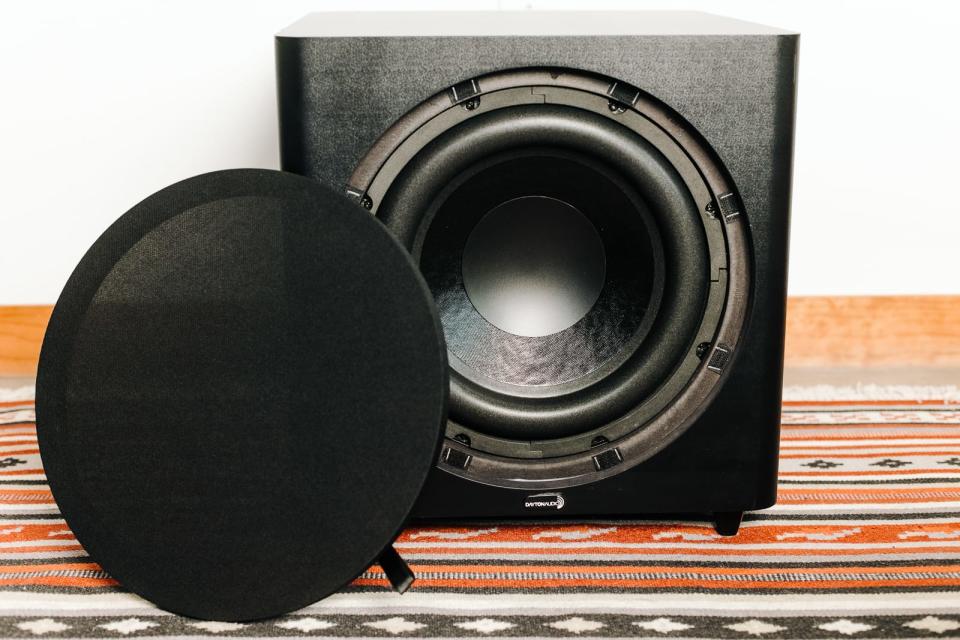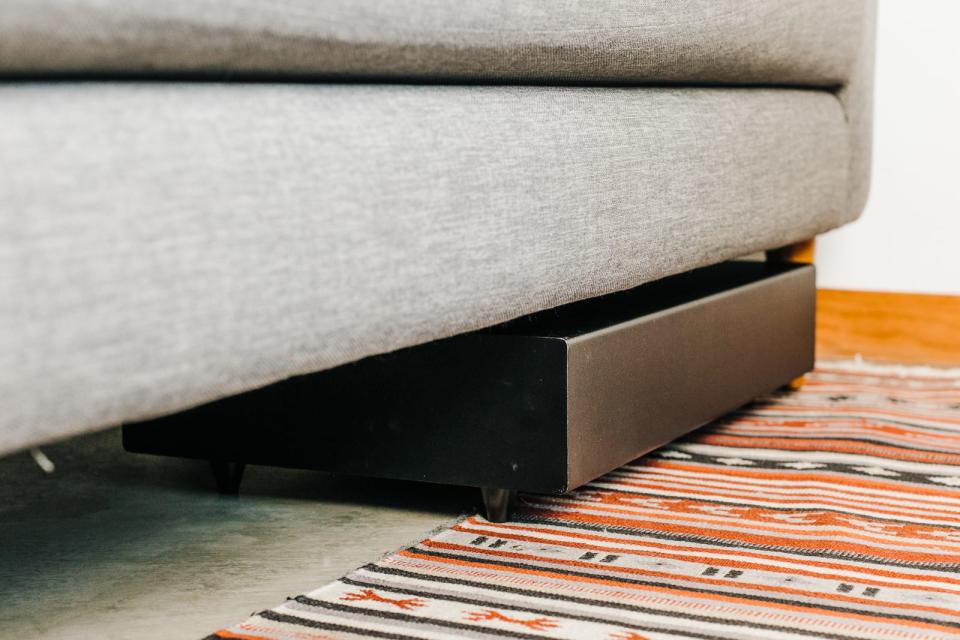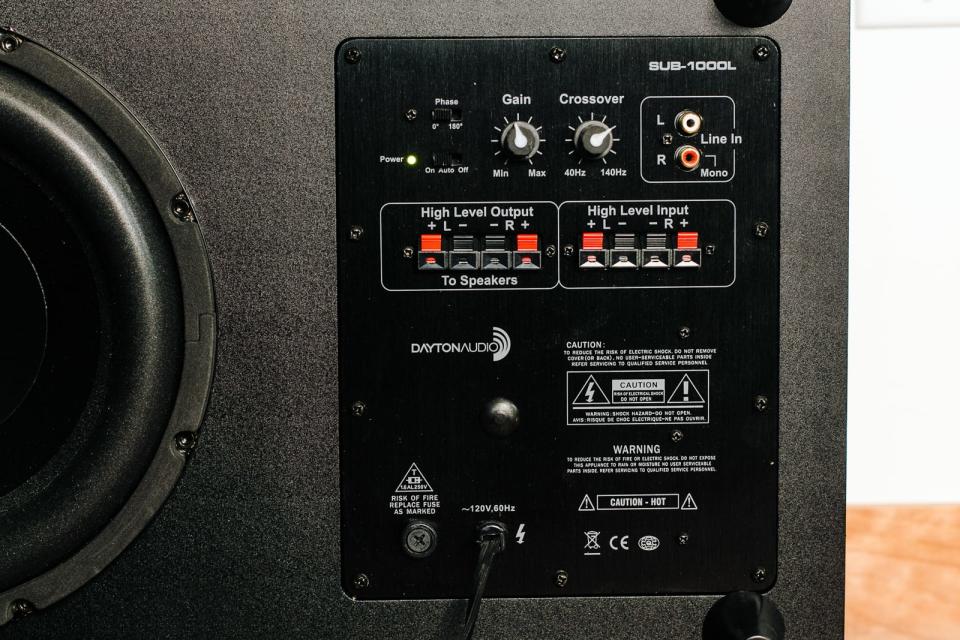The best budget subwoofer
The Dayton Audio SUB-1200 is Wirecutter's new top pick in this category.

By Brent Butterworth
This post was done in partnership with Wirecutter. When readers choose to buy Wirecutter's independently chosen editorial picks, Wirecutter and Engadget may earn affiliate commission. Read the full guide to budget subwoofers.
Adding extra bass with a subwoofer is the surest way to make a sound system more satisfying. Our new pick for the best budget subwoofer is the Dayton Audio SUB-1200. It kicks out enough deep bass to shake your couch, it's easy to hook up, and it's a little more attractive (or a little less unattractive, depending on your perspective) than most budget subs.
The Dayton Audio SUB-1200 12-inch subwoofer is a step up from the other budget subs we tested in a few ways. It has a more powerful bass than similarly sized models we tried, which means it can deliver a little more of that satisfying couch-shaking that makes action movies more realistic. Its rounded corners and flush-fit round grille make it more attractive than most budget subs, and its large rear panel and multiple connection options make it easy to connect to any system.
The Dayton Audio SUB-1000L 10-inch subwoofer is built for people who want more bass in their audio system but don't have space for a conventional subwoofer. At only 6 inches thick, it's slim enough to slip behind many couches and chairs and even under some couches. You can also attach it to a wall using the included mounting system. Its output doesn't match that of the Dayton SUB-1200, but it has enough power to work well in a modest home-theater system or in a stereo system with bookshelf speakers.
Why you should trust us
I wrote my first review of a subwoofer in 1991; since then, I have, to the best of my knowledge, reviewed more home audio subwoofers than anyone in the world. I've written for magazines including Sound & Vision and Home Theater and websites such as Home Theater Review, SoundStage, and LifeWire. I've been the most active and outspoken advocate of the CEA-2010 subwoofer measurement standard and wrote an online manual for it. In my work for the above publications, I have conducted at least seven multiple-listener subwoofer comparison tests, so I have my own impressions to guide me and also the impressions of other listeners. This page on my website provides a more extensive list of my audio credentials.
I've played bass-register instruments (including the upright bass, Chapman Stick, and fretless bass ukulele) since the early 1980s. I play several gigs a month with Tonic Trio and other jazz groups in the Los Angeles area, and I hear many drummers and other bass players at close range, so I have a solid familiarity with what bass is supposed to sound like in music.
I had help on this guide from two other listeners; both have participated in numerous audio tests I've conducted for Wirecutter and Sound & Vision, and they have also conducted many audio comparison tests of their own. The first is Geoff Morrison, who has written for Wirecutter, CNET, Forbes, and Sound & Vision; he has 19 years of experience in the audio industry and has done his own experiments in trying to build the ultimate subwoofer. The second is Wirecutter headphone editor Lauren Dragan. She holds a bachelor's degree in both music performance and audio production from Ithaca College, has spent several years in terrestrial radio, and currently works as a professional voice actor in Los Angeles.
Who should get this
A subwoofer is a speaker specifically designed to reproduce bass—deep sounds like the low boom of a kick drum or the thump of a bass guitar. You add it to an existing set of (usually small) speakers to give your system more bass and, potentially, a higher maximum volume. Adding bass to a small audio system is generally a good thing. It's what makes you tap your feet or bob your head when music is playing, it makes music seem more like it's being played in a large hall than in a small room, and it's essential for reproducing explosions and crashes in action movie soundtracks.
Subwoofers have a bad reputation with some people because if a subwoofer is not correctly adjusted, it may make a boomy, annoying sound. But a correctly connected and adjusted subwoofer is nothing but a plus. It just blends in and makes it seem like you have larger speakers. For tips on how to connect, position, and adjust a subwoofer, read our blog post on the subject.
Note that the shape and size of a room (as well as the placement of the subwoofer and the listening chair or couch) can make certain bass tones stand out and others practically disappear. Many audiophiles and home-theater enthusiasts like to use two or four subwoofers, which makes the bass sound more even as you move from seat to seat. Thus, it may be a better idea to buy two of these subwoofers than to upgrade to a more expensive single subwoofer.
How we picked
Based on our past experience testing subwoofers, we settled on a few criteria for the subwoofers we would consider for this test:
Price: Since this is a guide about budget subwoofers, we set a price ceiling of $300. There aren't that many subs between $200 and $300, as most models from long-established brands start at prices above $300. We plan to cover some of those brands—like SVS, Hsu Research, Emotiva, and Rogersound—in an upcoming guide to high-performance subwoofers.
Size: We wanted to pick subwoofers that would make a clear improvement in bass for small systems, so we didn't seriously consider any models with woofers measuring less than 8 inches, and we focused on models with 10-inch or 12-inch woofers. It's possible for smaller subwoofers to deliver satisfying bass, but that requires sophisticated engineering and construction that's likely impossible in our price range.
Customer support and product availability: Subwoofers are the most heavily stressed component in an audio system, and thus the most prone to failure, so it's important that the subwoofer manufacturer offers solid customer service and support. Below about $200, we found several off-brand subwoofers that have little or no availability outside of Amazon, and no North American customer-support phone number. We eliminated these from consideration.
Inputs: If you are using the subwoofer in a stereo system instead of a home-theater system, it's likely you will need to connect speaker cables, rather than line-level (RCA) cables, between your stereo and the subwoofer, so we focused on subwoofers that offer both speaker- and line-level connections. See our blog post on subwoofer setup for more information on this topic.
In the course of preparing the original test and the two updates of this guide, we've tested a total of 18 models, including five models for this update.
How we tested
The primary criteria that our panelists considered in our evaluations were:
how much clean bass a subwoofer can put out
how deep the subwoofer can play
how natural the bass sounds (i.e., not excessively boomy or punchy)
appearance
enough inputs to accommodate any common connection scenario
We conducted all of the listening tests in the same acoustically treated listening room I've used to test more than 130 subwoofers over the past 17 years. I have run countless tests and measurements in this room, had dozens of manufacturers set up their subwoofers in it, and at one point even had a scientist from Harman International come over to run tests in my room using as many as four separate subwoofers. I know this room's characteristics (and how they affect speaker performance) extremely well.
Each of the subwoofers went into my room's "subwoofer sweet spot," the place where I've found most subs to sound their best from my favorite listening chair. I connected the subwoofers to my home-theater receiver (a Denon AVR-2809ci for the original tests and a Sony STR-ZA5000ES for later tests) and used a surround-sound system made up of Sunfire CRM-2, CRM-2C, and CRM-BIP speakers. I used a crossover point (the frequency at which sounds are redirected from the speakers to the subwoofer) of 100 hertz, what you might use with a small set of speakers; this gave us a little more bass from the subs and a little less from the speakers, making the test tougher on the subs.
To make sure the subwoofer volume levels were set correctly, I first used the receivers' built-in test tones and a RadioShack sound-pressure level meter to get the setting close. Then I used TrueRTA spectrum analyzer software, a Focusrite Scarlett 2i2 USB interface, and a calibrated Earthworks M30 measurement microphone to check the level of the subwoofers relative to the level of the sound coming from the speakers using TrueRTA's built-in pink noise generator.
For my listening, I used several of the toughest bass test tracks I know of, including Holly Cole's "Train Song," Olive's "Falling," and the recording of Camille Saint-Saëns' "Symphony No. 3 (Organ)" from the Boston Audio Society Test CD-1, which has notes that drop down to 16 Hz. (How deep is that? It's the lowest note a standard electric bass could play if its scale length was 7 feet.) I also used bass-heavy action-movie soundtracks via Blu-ray, including U-571 and San Andreas. Then I brought Geoff and Lauren in for blind listening sessions, using a thin black drape to hide the subs' identities.
I concluded by running CEA-2010 output measurements on each subwoofer. This measurement provides an accurate and easy-to-understand baseline assessment of a subwoofer's performance, using test tones that simulate the bass content of music and movies. I've found that CEA-2010 results correspond well with blind-listening test results but provide a more precise comparison than listening tests can. The higher the number, the louder the subwoofer will play, and the clearer it will sound even if it's not cranked to the max. I keep a log of all my CEA-2010 results here.
Below are the CEA-2010 results for many of the subs we tested, citing an average output in the mid bass (the region from 40 to 63 Hz, which corresponds to the bottom notes of a standard electric or upright bass) and the low bass (the region from 20 to 31.5 Hz, corresponding to the deepest bass notes in hip-hop and EDM and the couch-shaking explosions in movie soundtracks). Click here to see an embedded chart that includes all the data points.

Our pick: Dayton Audio SUB-1200
The Dayton Audio SUB-1200 delivers a combination of output, sound quality, and style that no other budget subwoofer we've tried can match. It has enough bass output for a mid-size stereo or home-theater system, and it has a clean, natural sound—something especially important for music listening. It uses a 12-inch woofer in a ported enclosure, driven by a 120-watt internal amplifier, and it measures 16¼ by 16¼ by 17¾ inches (HWD).
The SUB-1200 puts out an impressive amount of deep bass for its price. It's easy to hear and even easier to measure. The sub put out an average of 114.8 dB in the mid bass and 102.0 dB in the low bass. This is 1.1 dB less and 2.7 dB more, respectively, than our previous top pick, the Monoprice 9723. Surprisingly, the SUB-1200's average output is almost the same as Dayton Audio's larger, more expensive SUB-1500, the differences falling within the specified ±1 dB range of error for this measurement. That's impressive.

Of all the budget subs we've tested, the SUB-1200 delivers the best blend of definition and tunefulness in the upper and mid bass, as well as couch-shaking power in the low bass.
When set up and adjusted correctly, the SUB-1200 doesn't produce the booming, garbled, distorted sounds for which cheap subwoofers are sometimes reviled. It sounds smoother than most budget subs (and some much more expensive models) because it doesn't accentuate the "punch" of bass tones—that pressure you feel in your chest when you're right next to a kick drum or bass amp.
While no budget subwoofer stands any chance of being mistaken for the work of Philippe Starck, we think the SUB-1200 looks a little nicer than most of its competitors, with a flush-fit speaker grille and large-radius vertical rounded corners. (You have to admit that at least they tried.) It also doesn't have (or need) a large, finned heat sink on the back, so it's easier to push back against a wall.

The SUB-1200 offers line-level RCA stereo inputs, which make it compatible with receivers that have a line-level subwoofer output (included on all surround-sound receivers and some stereo receivers). If your receiver lacks a subwoofer output, the SUB-1200 also has speaker-level input and output connections, so you can connect speaker cables (in sizes up to 14 gauge) from your receiver or amplifier to the subwoofer, and then from the subwoofer to the speakers.
Flaws but not dealbreakers
There's really nothing we don't like about the SUB-1200 for the price. Note, though, that our comments about the sound are subjective, and that some music-oriented listeners may prefer a subwoofer with a punchier sound (although in this price range, that will likely require compromising the deep bass performance). There are many subwoofers that can play louder and/or deeper, but they all cost substantially more.
Also great: Dayton Audio SUB-1000L

Most subwoofers are blah-looking black boxes that take up a pretty good amount of space and detract from a room's decor. The Dayton Audio SUB-1000L, on the other hand, is only 6 inches thick, so you can probably hide it behind a chair or a sofa, or maybe even under the sofa, and it thus could go unnoticed (or at least less noticed). It has legs that elevate the woofer off the floor or keep it away from the wall, so there's no concern about muffling the sound. It's 25 inches wide and 15¾ inches deep. You can place it horizontally or vertically, and it even includes brackets that let you attach it directly to a wall. It has a 10-inch woofer powered by a 100-watt internal amp.

The SUB-1000L's output can't compare to the Dayton Audio SUB-1200, but it's respectable for such a slim, inexpensive subwoofer. Our measurements showed an average of 108.8 dB in the midbass and 97.0 dB in the low bass, compared with 114.8 and 102.0 dB, respectively, for the SUB-1200. The SUB-1000L's closest design competitor, the Monoprice SSW-10, averages 113.2 dB and 89.9 dB, respectively.
When we played action movies, the SUB-1000L had more power than we expected on the deepest bass notes. It also sounds fairly satisfying playing the deep bass tones in hip-hop and dance music. It can't match the punch, power, and clarity of the SUB-1200, but its combination of room-friendly design, sound quality, and price is available in no other sub we've tested.

The SUB-1000L has the same inputs as the SUB-1200: speaker-level inputs and outputs plus line-level RCA inputs. This makes it easy to incorporate the sub into a stereo or surround-sound system.
What to look forward to
We'll continue to watch for the introduction of new budget subs, and for a future update we'll consider adding a budget pick—a smaller 8-inch model, probably under $100, that would be good for a small office or bedroom.
The competition
The BIC America V1020 is a previous pick. It's a nice, compact, very good-sounding subwoofer, and we still recommend it, but its price has gone up since we originally picked it.
The BIC America V1220 has impressive power in the deepest notes but lacked mid-bass punch and didn't blend as smoothly as the V1020 did with the speakers we used.
The Dayton Audio SUB-1500 is a nice subwoofer that doesn't really perform significantly better than the less-expensive SUB-1200.
The Monoprice 14567 sounds pretty good, but the Dayton Audio SUB-1000L and the Monoprice SSW-10 deliver substantially greater output for roughly $40 more.
The Monoprice 605999 is a pro-style subwoofer that can be used in the home, but our top picks and the BIC V1020 offer more kick for fewer bucks.
The Monoprice 9723 is our previous top pick. It delivers surprisingly good sound quality and lots of deep bass output for the price, although we do have a slight overall preference for the Dayton Audio SUB-1200. However, the 9723 often goes out of stock, and while we haven't had any problems with the three samples we've tried, we've seen too many complaints about defective units to ignore.
The Monoprice SSW-10 slim subwoofer is very similar in size and performance to the Dayton Audio SUB-1000L, but it's a little pricier and its low bass performance isn't as good. We felt that the SSW-10 sounded punchier in the mid bass, while the Dayton SUB-1000L delivered a more even, natural response.
The OSD Audio PS10 is appealingly compact, but it doesn't deliver as much performance for the price as the Dayton SUB-1200.
The OSD SS8 is a low-profile subwoofer similar to, but smaller than, the Dayton Audio SUB-1000L. It's very pricey for the performance it delivers.
The Pioneer SW-8MK2 is our former pick for a compact model. It's a great sub, but we like the Dayton Audio SUB-1000L better as a compact pick.
In our tests, the Polk PSW110 didn't have much punch or power for its size; the smaller, less-expensive PSW111 is more impressive, but we think the Dayton Audio SUB-1000L is a more appealing and versatile compact pick.
The PSB SubSeries 100 is nice if you really, really need a super-tiny subwoofer, but it can't touch the price/performance ratios of our picks.
The Yamaha YST-SW012 and YST-SW215 both distorted on deep bass notes and couldn't deliver much low-frequency rumble.
This guide may have been updated by Wirecutter. To see the current recommendation, please go here.
When readers choose to buy Wirecutter's independently chosen editorial picks, Wirecutter and Engadget may earn affiliate commissions.
